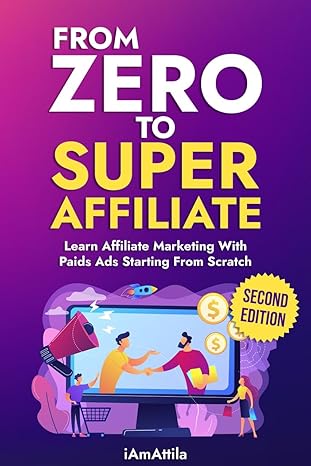Since Affiliate Marketing is dying, affiliates are looking for the next best thing, where they can reap the low hanging fruit and make F U Cash to buy bottle service, lambos, and head up the strip clubs.
Search Arbitrage campaigns are very popular these days especially on Native traffic sources like Taboola for example.
With arbitrage campaigns, you don’t even need to deal with creating landing pages or any kind of presell pages, since these campaigns are running with direct linking, so they don’t require an advanced and complicated setup to get started. The most important thing for it to print cashoola for you, is using an auto optimizing tool -for that we use the one and only, The Optimizer. Without this YOU CANNOT make it work, as it must be used to automatically optimize campaigns and stop bad performers and increase budgets on good performers. You can try, but if you wanna LAMBO, u need it.
So the setup is pretty easy, however arbitrage campaigns have 2 main constraints which are not the easiest to deal with.
[toc]
These constraints are:
#1 – Most search feed providers require past ad spend proof, as well as they usually accept marketers that have proof of at least $1,000 – 10,000 ad spend per day.
#2 – Sometimes revenue can take up to 2 days to be approved and to be visible in your stats, and because of that it can be hard to optimize your campaigns.
How to Find Search Feed Networks?
You can simply do Google research for the best search feed provider networks, or you can ask more experienced marketers on internet marketing forums, like iAmAffiliate for example.
But to save you some time here are four networks that are good for starting:
- System1
- Tonic
- Domain Active
Search Feed Offers
Search feed offers are result feeds of specific keywords for which others are bidding on search engines like Google. So when you promote arbitrage links this is what you promote basically.
Marketers who are buying search traffic on Google can accept clicks from these feeds by checking the ’’Include Google search partners’’ box.

These offers are divided into the following types:
1-Click Flow – When the visitor is directly served with the promoted service/product listing link.
2-Click Flow – When the visitor is served with a pre-lander, that will send him to the promoted service/product listing links.
Conversion Payouts
The offer objective is that we want to make visitors click on the search result served through our search feed. However, the payouts for this might seem to be low. Making these offers convert may seem very hard since the revenue per click (RPC) can be as low as $0.01 to $1.
But in reality, these offers have high conversion rates in general, which can also depend on the GEO and the product or service of course, but in general, the conversion rate is 15% or more on these offers, which is pretty nice.
How to Setup a Campaign
Many marketers are running search feed arbitrage campaigns without even using a campaign tracking tool, they just put search feed links as their final URL.
This may sound good because it’s quick and easy, however, it is not really efficient.
Ad tracking tools are so useful, I can’t even imagine running any kind of campaign without a proper tracking tool.
My favorite tracking tool is Redtrack. It has an easy-to-manage interface with all the advanced features at a great price! They even offer a 14-Day Free Trial so you can’t go wrong with it.
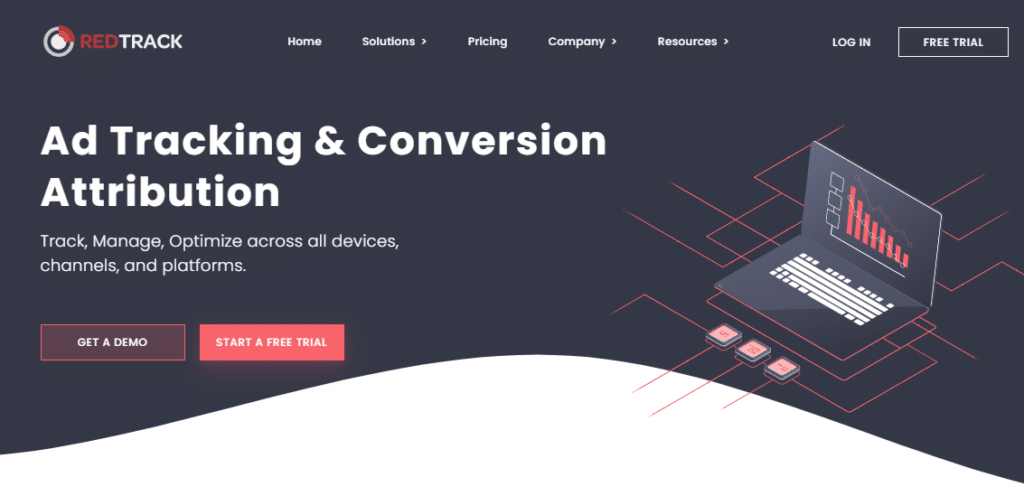
By using a tracking tool like RedTrack you can easily keep tracking your Spend/Revenue accurately, plus you can use auto-optimization with API-based automation tools like The Optimizer Native.
You can also add different offers and verticals from different search feed networks in a single campaign and RedTrack will A/B test it for you.

Easy Funnel – Targeting 1 GEO
For this, all you need is to create a simple tracking campaign, in which you add only one offer to your flow, and that’s it.


Advanced Funnel – Targeting Multiple GEOs
You can also target and test multiple GEOs within a single campaign with RedTrack, what you need is to set up some rules in your flow, to ensure you send the visitors to the correct search feed/offer.

So when you create your flow in RedTrack, you need to create a separate funnel for each GEO you are targeting.

And one for the untargeted GEO traffic. To set up a funnel for the non-targeted country traffic you need to create a new funnel and in the filter settings selected EXCLUDE, and add the countries that you are TARGETING as a value.

So if the traffic is NOT coming from the USA or UK (in this example) they will be redirected to your Global offer.
Optimizing Your Campaigns
When it comes to arbitrage campaigns and average low payouts, we need to start optimizing as soon as possible to block bad-performing publishers and adjust our bids.
So if you have an average RPC of $0.65 for example, you should block widgets with a low conversion rate after you spend around $1.5 on them.
The most important metrics you need to monitor regularly are:
- Conversion Rate
- RPC (Revenue Per Click)
- ROI (Return On Investment)
Updating your Revenue Manually
Unfortunately, until you get massive data and traffic you will need to upload the conversions manually to your tracker once they are approved.
You will need to manually download the approved conversions from your search feed network as a CSV and upload them to RedTrack to see the correct revenue data in the tracker.

You have to be careful and ensure that you are not posting the same conversion twice, for example, if you upload conversions multiple times a day. Uploading the same conversions twice will give you false results and it will make the optimization hard.
Auto-Optimization
Since it’s not easy to make big profits with a single campaign, dealing with low payouts and aggressive optimization, auto-optimization is extremely helpful when it comes to traffic arbitrage campaigns.
That’s why I like to use TheOptimizer Native. With it, you can even set up Automatic Revenue Update!
If you are uploading your conversions consistently to RedTrack, you should simply set up a schedule on TheOptimizer where you’re basically telling the system to pull your campaigns data every day at a specific hour for Yesterday, Before Yesterday, Last 3 Days or Last 7 days.

Auto-Optimization Rules
Since both the costs and revenues are flowing into our platform, we can easily create auto-optimization rules for our arbitrage campaigns.
Examples for Auto-Optimization Rules:
-Block Widget Rule 1
Considering data from: Past 14 Days / Excluding: Today & Yesterday
IF Traffic Source Spend is greater or equal to $X.X AND ROI is less than -40%
Run rule every 10 or 20 minutes
-Block Widget Rule 2
Considering data from: Past 14 Days / Excluding: None
IF Traffic Source Spend is greater or equal to $X.X AND Tracker Conversion Rate is below YY%
Run rule every 10 or 20 minutes
-Tweaking Bids
Considering data from: Last 7 / Excluding: Today & Yesterday
IF Traffic Source Spend is greater or equal to $X.X AND ROI is greater than YY% AND ROI is less than ZZ% AND Hour of the Day [select 3 specific hours in a week]
Set Bid to 80% of the EPC, then do not allow the bid to go below $x.xx AND not above $y.yy
Run rule every 1 hour
Top Automation Rules For Search Arbitrage in Optimizer🔝💣🔥
1. Block Non Converting Widgets / Sites
We want to stop any widgets or publisher sites that just get clicks on the traffic source, but don’t actually lead to conversions on the promoted search feed.
Rule type: Block Widget/Publisher
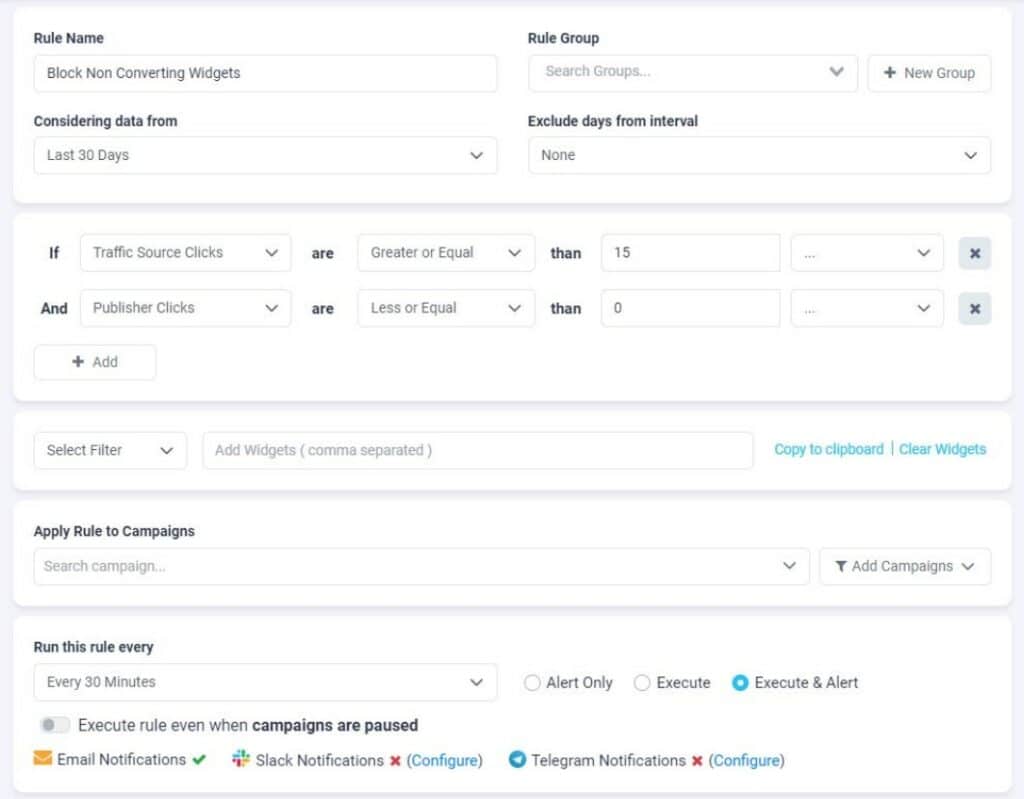
This rule works for almost all native ad networks, except for Outbrain. If you’re running campaigns on Outbrain, it’s better to create a similar rule that blocks sections instead of widgets. It’s all about finding what works best for each platform and adjusting accordingly.
2. Block Widgets/Sites where roi is -50% or worse
Let me explain this rule to you in simple terms. With the Optimizer you can stop using any widgets or publisher sites that have converted, but the return on investment (ROI) is worse than -50%.
To be more specific, if a widget’s ROI is equal to or worse than a certain percentage of negative value (let’s call it XX%), no matter how much you try to adjust the bidding strategy, it won’t help recover the ROI.

Therefore, it’s crucial to analyze your campaign data and set a low ROI threshold that works best for each traffic source and targeted country. This threshold will differ from one platform to another, so it’s important to rely on data to determine the appropriate threshold. Ultimately, this will help improve the efficiency of your marketing efforts and ensure a better ROI.
3. Block Push Traffic Sites
With this rule The Optimizer is to prevent push traffic widgets from appearing in your campaigns. This is important because it can help you avoid overspending and potential compliance issues with your feed provider.
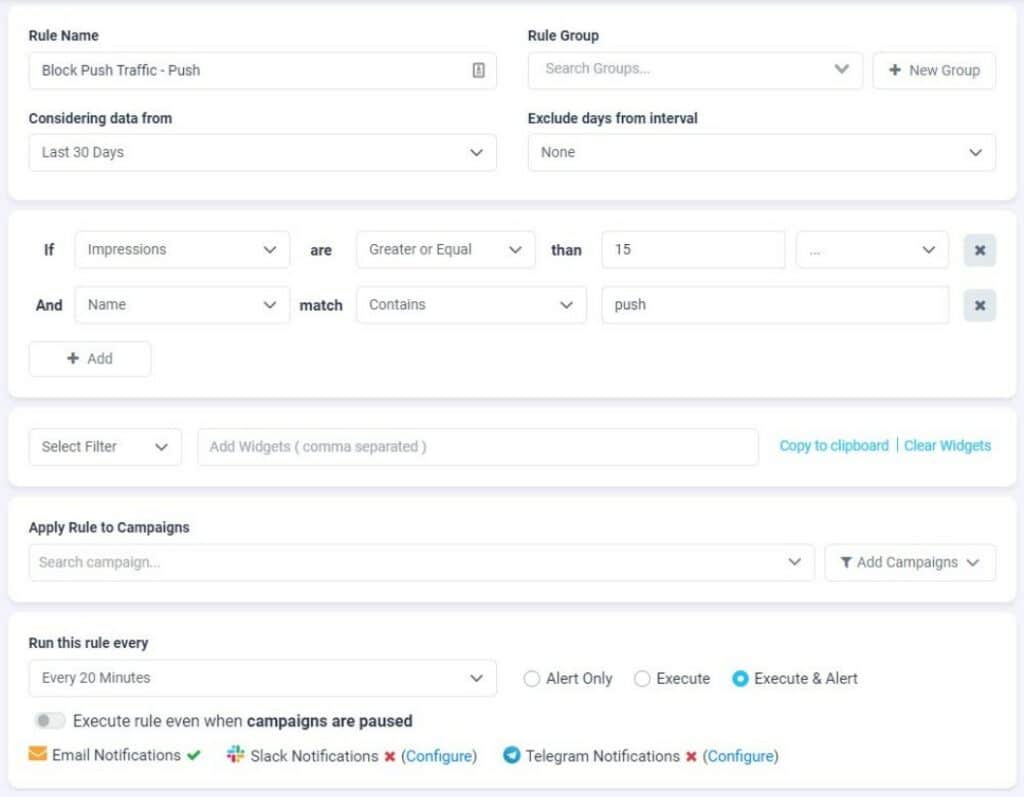
It means that you can use this rule to block any uncompliant widgets or publishers from your campaigns. You can also add a condition to the rule that includes the word “push” as a qualifying name string to ensure that push traffic widgets are blocked.
In addition, you may want to create a similar rule that includes the word “notif” as the qualifying name string. This will help you block any other push notifications that you don’t want to receive traffic from. Using this approach, you can easily customize your rules to block any widgets that you don’t want to see in your campaigns.
4. Unblock Profitable Widgets
The goal is to reactivate any profitable widgets or publisher sites that were blocked by another rule. This is because it’s not uncommon for a widget to be blocked but then become profitable once the revenue is confirmed for search arbitrage campaigns, which can take 24-36 hours.
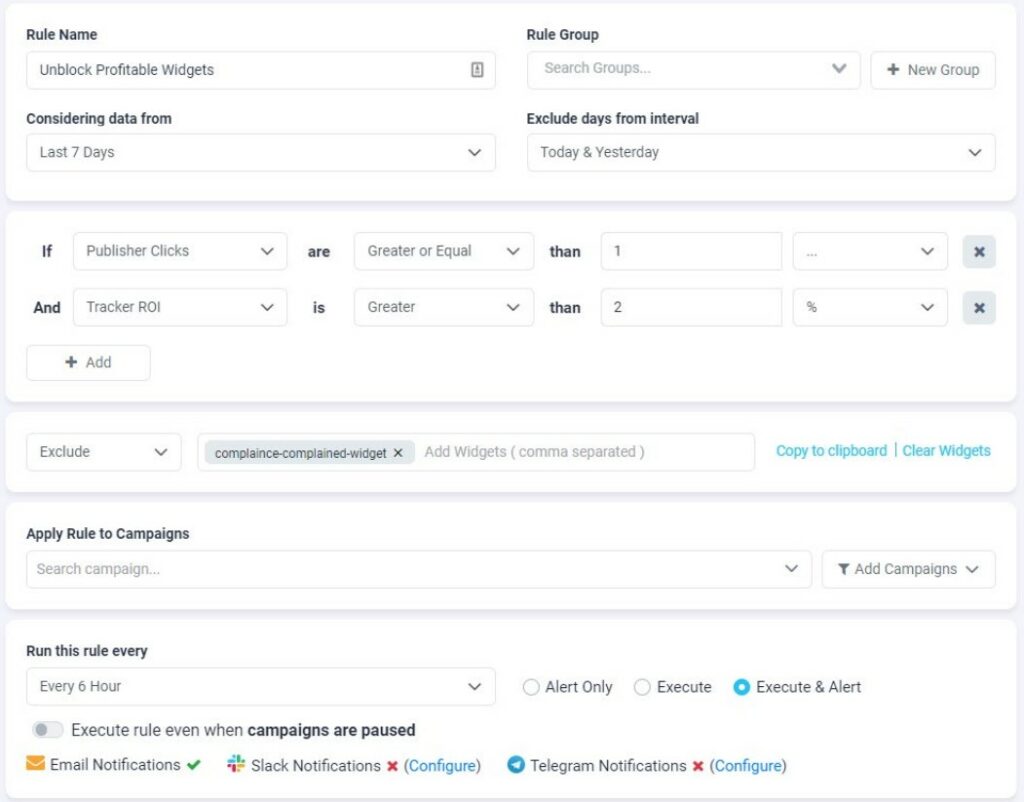
The rule type is Unblock Widget/Publisher, meaning that The Optimizer will unblock any widgets or publishers that were previously blocked by another rule. However, it’s important to note that when creating unblock widget rules, it’s a good idea to include any uncompliant widget ids in the widget filtering section. You can do this by selecting “exclude” and then adding the widget ids to the widgets box. This will help you ensure that only compliant widgets are unblocked, and any uncompliant ones remain blocked.
5. Change Bid – Seek 10% Profit
The goal of this rule is to update the widget bid to 90% of its EPC while seeking a 10% profitability.
Rule type: Change Site Bid


Let me explain the different options we have set up in this rule to ensure that it executes correctly. We have used a screenshot of the rule as a reference to explain these options.
Firstly, we have chosen to consider data from the last 7 days only. Using a larger data window could result in outdated data, which may negatively affect our decision making.
Secondly, we have excluded the “Today” or “Today and Yesterday” from the selected time frame. This is because revenue confirmation takes time, and it’s safer to exclude these days to ensure that we are working with accurate data.
Thirdly, we have set up two ROI conditions with logical operators “Greater than” and “Less or Equal to”. This is to define the ROI range we want this change to happen. We have also added an hourly schedule with a specific time zone and selected a few hours from the week. The goal of this schedule is to have bids changed only 3 times a week, on the selected hours and days of the week. We have set the rule to run every “1 hour” to ensure that it executes only during the selected hours of the defined schedule.
Lastly, we have specified how the bid will change according to the EPC (earnings per click) and defined the minimum and maximum allowed bid range. This will help avoid under-bidding and over-bidding, ensuring that we are bidding within the appropriate range.
By setting up these different options, The Optimizer can avoid competing against the traffic source optimization algorithm and ensure that the rule executes correctly to help maximize profits.
6. Change Bid – Increase Bid
The goal of this rule is to increase the bid on profitable widgets in order to get more traffic from them.
Rule type: Change Site Bid


The screenshot shows a rule with several settings to ensure it runs properly. The data used is from the last 7 days, as using a longer period could lead to outdated information. Excluding “Today” or “Today and Yesterday” from the selected time frame helps ensure revenue confirmation is accurate.
The rule only specifies a minimum ROI range for bid increases, but an upper limit can also be defined. An hourly schedule is included to change bids only 3 times a week on selected hours and days, which avoids competing with the traffic source’s optimization algorithm.
Running the rule every 1 hour ensures it only executes during the scheduled times. Bidding settings specify how the bid changes based on EPC and define a minimum and maximum bid range to prevent under-bidding and over-bidding.
7. Change Bid – Decrease Bid
With this rule The Optimizer can automatically decrease the bid on widgets that are showing signs of a decreasing ROI, indicating that they may be approaching a negative ROI.
Rule type: Change Site Bid


To make sure our bid change rules are effective, we only look at data from the last 7 days. Using a bigger time frame can give us old information and lead to bad decisions. We also exclude “today” and “yesterday” from the data to make sure we have accurate revenue numbers.
Our rules are based on the ROI range we set. We only increase the bid when the ROI is above a certain minimum range, but we can also set an upper limit. We have an hourly schedule for our rules that changes bids only three times a week, on specific days and times. This prevents us from competing with the traffic source optimization algorithm.
To make sure our bids don’t go too low or too high, we set a minimum and maximum bid range. This helps us avoid under-bidding and over-bidding.
8. Daily Budget Change – Scale Up
The goal of this rule is to raise the daily budget when there are days with potentially good performance.
Rule type: Change Campaign Budget

From the screenshot, you can see that we’ve set up two basic requirements with The Optimizer. The first one checks the daily expenditure based on the current budget allocated to your campaign, while the second one examines the Publisher CVR.
When both conditions are met, a 50% boost to the daily budget is added based on the current daily budget amount. It’s important to note that you have to depend on the conversion rate that’s reported due to the delay in confirming revenue, so you can make decisions during the day. If the search feed provider reports revenue during the day, you can use ROI instead.
9. Daily Budget Change – Budget Reset
This rule has a simple objective: to set a fixed daily budget for your campaign, which will be reset every day. It can be useful in conjunction with other rules that increase or decrease the budget, ensuring that the budget starts fresh each day.
Rule type: Change Campaign Budget

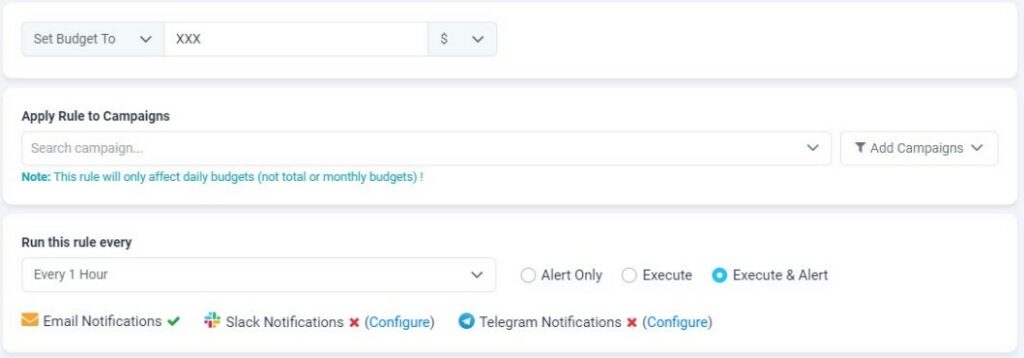
10. Daily Budget Change – Decrease Budget
The goal of this rule is to lower the budget of a campaign if it starts showing poor performance in its early stages. This type of rule is useful especially for campaigns that have a large budget and when you want to prevent substantial losses.
Rule type: Change Campaign Budget

When you’re setting up rules to decrease your campaign’s budget, it’s important to consider the daily changes in your campaign’s performance. Adding an hourly schedule as a rule condition can help you avoid making sudden changes to your campaign’s budget based on incomplete data.
This can prevent you from mistakenly lowering your budget too soon and potentially missing out on a profitable campaign.
11. Smart Lists – Don’t Limit Yourself to Rules
Sometimes, you may come across widgets that consistently perform poorly or don’t meet your standards across multiple campaigns. Simply relying on automatic optimization rules may not be sufficient in these situations. The Optimizer can address this issue, by Smart Lists. By utilizing the data from your campaigns, Smart Lists can significantly reduce the amount of budget needed for testing while optimizing your campaign to the fullest.
Smart List example:

In the above example, we made a Smart List that gathers all push notification publishers and blocks them on all campaigns that use this list. You can do the same for other widgets as well. A helpful tip is to create and organize Smart Lists based on specific factors like country, device, operating system, browser, and so on. The more detailed you are when creating Smart Lists, the more effective and dependable they will be for future use.
For more info about The Optimizer and it’s features click here.


